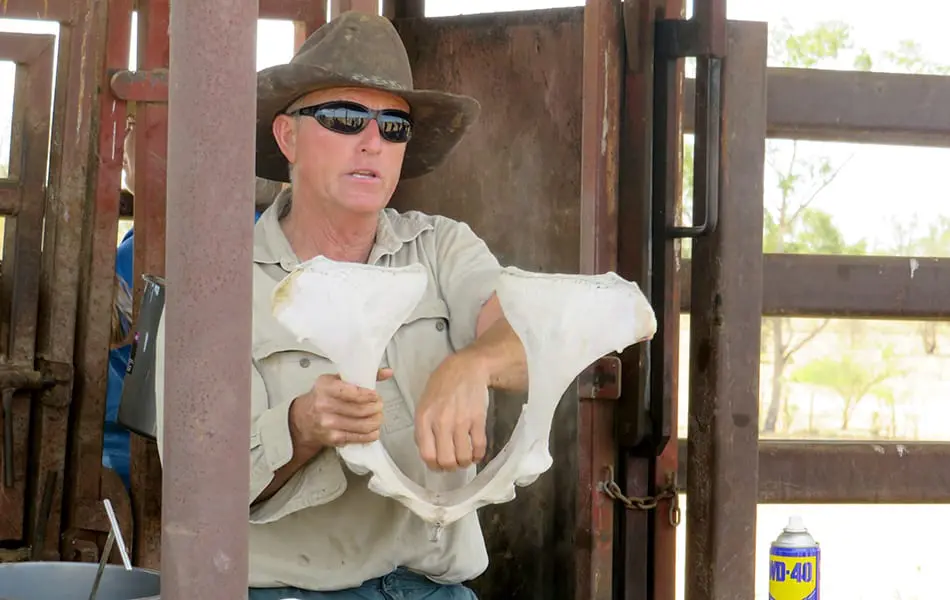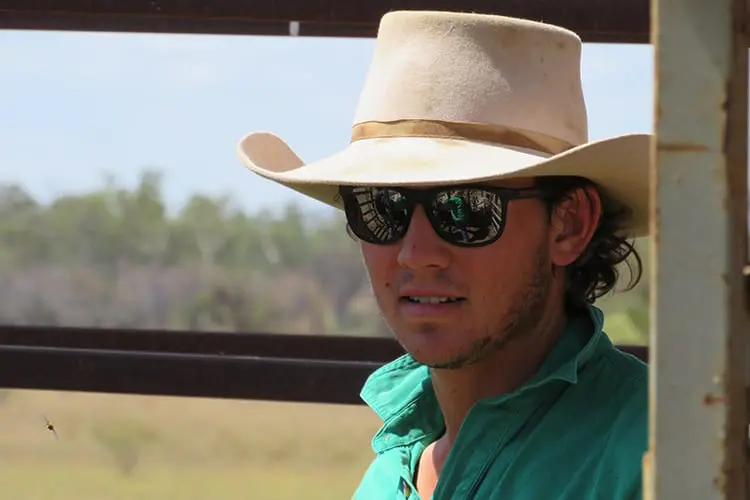
Workshop participants at the end of a highly successful workshop. Everyone agreed that they learnt a lot about preg testing and breeder and herd management.
Veterinarian Ian Braithwaite uses a bovine pelvic bone to demonstrate the correct technique when pregnancy-testing cows.
Class is in… Theory first, practical later. Attendees at veterinarian Ian Braithwaite’s pregnancy testing and breeder management workshop pay attention during “class”.
Topics covered at the workshop:
- Early detection of non-pregnant heifers and breeders, allowing for informed decisions on retention or culling of animals from herd.
- Early detection of some reproductive abnormalities.
- Real data on herd performance:
- individual animal, group and herd conception rates;
- death rates between mating and weaning;
- accurately predict the size of the herd each season, and match actual stocking rate to available pasture; and
- identification of reasons behind low reproduction rates (bull performance, female nutritional inadequacies, untreated diseases in mobs, or solely unproductive individual females).
- Separation of groups of females calving at the same time:
- sale of under-performing cattle if a shortage of grass is predicted; and
- targeted mob supplement program specific to nutritional needs (rather than blanket supplementation).
Watch this video that features veterinarian Ian Braithwaite when he hosted a workshop near Glenden for the LDC project in 2019.
Workshop back by popular demand
By popular demand, veterinarian Ian Braithwaite returned to the BBB in September to run a pregnancy testing and breeder management workshop. There were 22 people at the Havilah Station event.
Reproduction performance is probably the single most important factor affecting the economics and profitability of beef cattle breeding operations in Australia.
Producers are seeking help to manage their herds more effectively to achieve optimum breeder herd performance, especially reproduction performance.
For cows, reproduction is about the capacity to conceive and rear a calf to weaning each year following puberty. For bulls, reproduction is about the capacity and ability to sire a large number of viable offspring each mating year.
The two-day workshop focused on the theoretical and practical skills of pregnancy testing and foetal ageing in cattle, and how to integrate the learned skills and information into decision-making practices about livestock efficiency and performance, landscape resilience and business profitability.
Mr Braithwaite said producers were seeing improvements to reproduction and scanning rates thanks to early weaning, containment feeding and joining in confinement.
“Early weaning can significantly reduce feeding costs and allow females to build condition ready for joining,” Mr Braithwaite said.
“Selecting replacement heifers from those weaned in the first branding round ensure producers get the genetics from the highly fertile ones.
“Managing nutrition requirements is also important. Knowing how much feed needs to go into the animals at certain periods of the year and how much that affects joining and reproduction rates means you can manage input costs.
“Making cattle, country and people the top priorities is the best foundation on which to build a successful beef operation and to trial innovations.
“Don’t overuse the pasture, treat the country right. Make sure all cattle are productive, don’t carry any passengers, and then make your management decisions fit in with what is best for livestock.“
The workshop is part of an integrated program that the LDC Grazier Support activity area is delivering in 2020.
Greg Lennox, from Eungella, attended the workshop.
Bec Lathwell of Havilah.
Gabby Kenny, of Llanarth, Belyando.
Larissa Browning , Gunnadoo.
Lachlan Cox, of Gattonvale.








